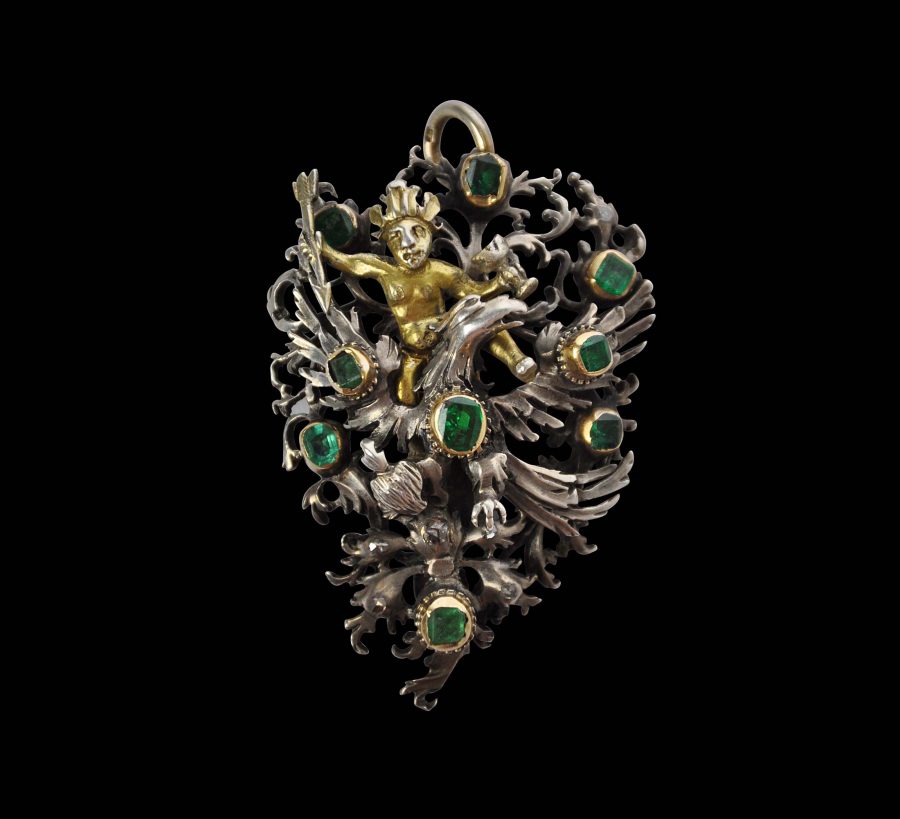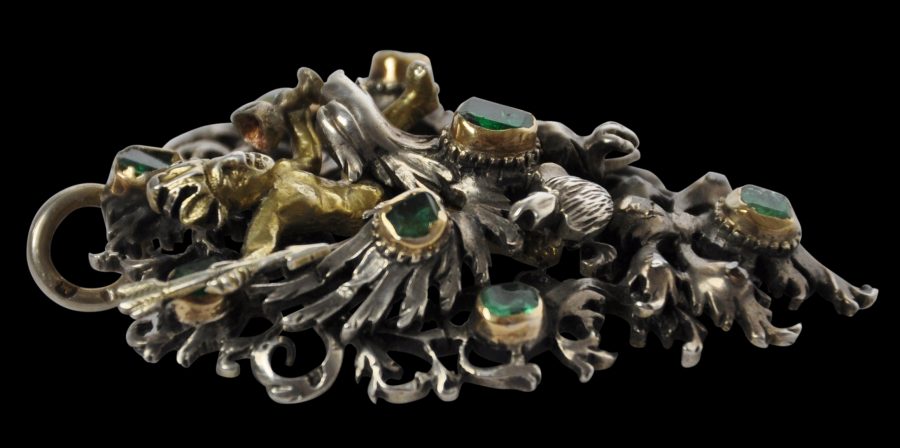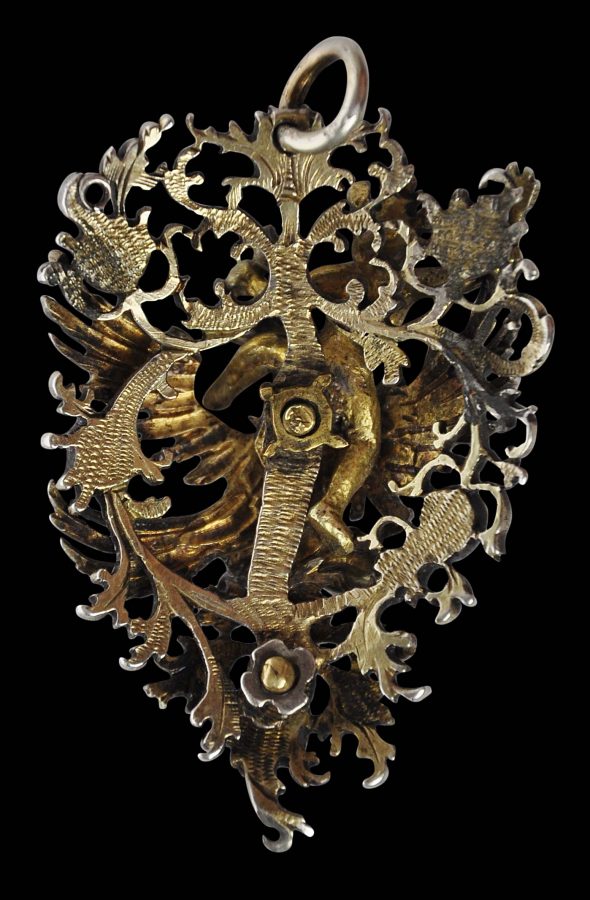This very fine silver and gold-plated (gilded) pendant features a cupid-like native figure wearing a feather headdress associated with the Aztec or Tupinamba nobility astride an eagle which in turn clutches a heart in its right claw, all set within a floral, leafy array. The native figure clutches a chalice or goblet in his left hand and an arrow in his right. The native figure’s well-formed body has been gilded, providing a wonderful contrast with the silver surrounds.
The pendent is set with large emeralds in gilded box settings and small rose-cut diamonds. The back is entirely gilded and also engraved.
Overall, the pendant is a remarkable allegory for the Americas: the eagle suggests the colonial power of Spain, the native with Inca feathers is self evident, and the heart is likely to represent the Sacred Heart of Christ.
It was made either in Spain or in South America, perhaps Brazil, for export to Spain. Certainly, in the eighteenth century, the Spanish aristocracy placed jewellery orders to far-flung manufacturers. Orders were sent to China and the Manila for example, and often this was trans-shipped via the Americas. Isabel Farnese awaited jewels ordered from Manila and China that were lost in a shipwreck 1716, despite the efforts of Philip V’s divers attempting to wreck the wreckage of ships sailing to Spain from Havana (Muller, 2012, p. 155).
A related gold and silver pendant set with diamonds and emeralds with a similar eagle and with similar stones in identical settings is in the national collection of Poland, in Wawel Royal Castle, and had formerly been in the collection of Poland’s imperial family. That pendant, described and illustrated in Nowacki & Piwocka (2011, p138) is described as ‘Hispanic’, has French import marks for the mid-19th century, and is believed to date to the end of the 17th or beginning of the 18th century.
The use of emeralds represents the huge mineral wealth of Spain’s Latin American colonies. Green gems in jewellery became very fashionable in eighteenth century Spain and its colonies on account of the new availability of emeralds from Columbia.
The Cupid figure has ‘native’-type features and wears a feathered crown akin to the feathered crowns worn by chiefs of the Tupinamba people of Brazil. Tupinamba crowns and capes of feathers from the scarlet ibis bird (guara) were first brought back to Europe in the early seventeenth century where they were collected as curiosities, but also incorporated into dress fro masquerades and the like (Reynolds, 2013, p. 277).
The spiky, leafy array is of a form associated with 18th century bodice ornaments and related jewellery produced in Spain and its colonies. A contemporary drawing of a such a piece set with emeralds and now in the Archivo del Real Monasterio de Santa Maria in Guadalupe is illustrated in Muller (1012, p. 163).
The imagery of a cupid-like native to represent the Americas appeared from the seventeenth century cross Europe. An example set amid the spiky, leafy foliage seen in this pendant appears in the stucco relief completed in 1685 in Bavaria’s Alteglofsheim castle. The figure wears a crown of feathers. (For an illustration, see Pollerob, Sommer-Mathis & Laferl (1992, p. 75). Another such figure can be seen as a cornerpiece of an engraved map produced in Paris in 1694 by Alexis-Hubert Jaillot and illustrated in Stratton-Pruitt (2006, p. 72).
The pendant has been fitted with a later gilded loop (but old) at the top to allow it to be suspended. There is a tiny, indistinct assay or control mark to one of the outer branches. One small leafy branch appears to have been lost to the top of the pendant but this is barely noticeable in the overall profusion of the piece. Overall, the pendant is in fine condition. It has a good weight for its size. It is rare, robust and wearable.
References
Carr, D., Made in the Americas: The New World Discovers Asia, Museum of Fine Arts, Boston, 2015.
Chadour-Sampson, Beatriz., personal interview in July 2015.
Forsyth, H., The Cheapside Hoard: London’s Lost Jewels, Museum of London, 2013.
Muller, P.E., Jewels in Spain 1500-1800, The Hispanic Society of America, 2012.
Nowacki, D. & M. Piwocka, Klwjnoty w Dawnej Polsce, Carta Blanca, 2011.
Pollerob, F., A. Sommer-Mathis & C.F. Laferl, Federschmuck und Kaiserkrone: Das Barocke Amerikabild in den Habsburgischen Landern, Eine Ausstellung des Bundesministeriums fur Wissenschaft und Forschung, 1992.
Reynolds, A., In Fine Style: The Art of Tudor and Stuart Fashion, Royal Collection Trust, 2013.
Stratton-Pruitt, S., et al., The Virgin Saints and Angels: South American Paintings 1600-1825 from the Thoma Collection, Skira, 2006.
Thornton, D.,A Rothschild Renaissance: Treasures from the Waddesdon Bequest, The British Museum, 2015.




